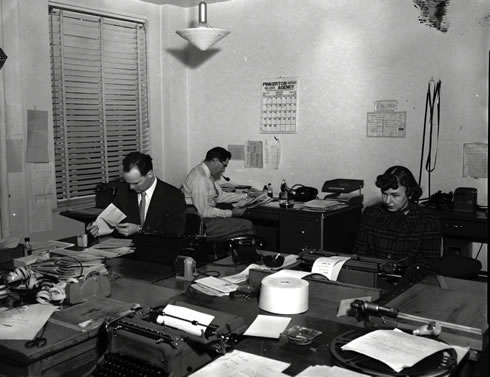
By Kris Leonhardt
Editor-in-chief
Part III in our series on WBAY’s history
Under Haydn Evans’ watch, sister radio stations WTAQ and WHBY were profitable within a year.
The staff in those days consisted of 9-10 people, including a salesman, traffic manager, two announcers, chief engineer, managing director, secretary and one or two engineers at the transmitter site in De Pere.
Evans operated as the general manager and sales manager.
“We always had trouble meeting the payroll and more than once a Green Bay merchant would pay us ahead of billing date,” Evans recalled in a memoir.
“In 1939, we began a daily Telephone Quiz. To the best of my knowledge this was the ‘first.’ Ten years later, in 1949, we started a program called ‘Party Line.’ Five years later there were hundreds of imitations and variations throughout the country.
“But, perhaps the most popular show we ever created was called ‘Armchair Detective.’”
With those new ideas and marketing measures, Evans turned the stations around and they started making money.
“Now, I don’t know at what point they started getting into TV. I don’t know what the impetus was, just because everybody was getting into TV at the time,” said station historian, Ted Miller.
“Around 1949-51, the FCC put a freeze on new TV stations. They’re about 108 or 180 in the country, and the FCC said hold on, all of these radio signals for TV might interfere with civil defense. So, they put on a freeze. WTMJ in Milwaukee was channel No. 3 at the time; that was the only TV station in Wisconsin, but people were interested. There were a couple thousand people in this area who had TVs just to pick up that one station in Milwaukee.
“So, everybody wanted to get a TV license. As soon as the FCC said the freeze is over we’ll start looking at it again, FCC approved two licenses for Green Bay. Not licensed, per se, they said we will do a channel No. 2 and channel No. 6 and for WBAY, Haydn Evans applied immediately for channel No. 6.
“Then, at some point during early 1952, as they’re about to put in the application, the engineers and some of the lawyers said, ‘No, go for channel No. 2. From an engineering standpoint, it’ll be much simpler. It’ll be much better for us.’ But he doesn’t know why; I never found an explanation of why, but channel No. 2 will be better for us. So, he applied for channel No. 2.
“The Press-Gazette and a group of Fox Valley businessmen were applying for channel No. 6.”
“There was also a TV station in Oshkosh, WOSH-TV. There was construction underway for a TV station in Neenah, WNAM. There was also in Marinette Menominee, WMAM, and they were working on a TV license. So it’s like everybody’s coming out from under a rock trying to get a license for TV.
“WBAY got the first one.”
The station got their license in November of 1952.
With the installation of a transmitter and temporary tower and antenna on Brown County’s Scray’s Hill, the station went on air March 17, 1953, with an eight-hour schedule and staff of around 25.
Next week: The early days
